This [electronic] version (2017) www.irishpapermoney.com/forum/viewforum.php?f=22 Numismatic Articles and Papers / Occasional Papers on Irish Paper Money
Recommended Citation
Mac Devitt, M. (2017). Banknotes on Jewellery in the Victorian Age. [Electronic version]. Accessed [insert date], from irishpapermoney.com/forum/ Occasional Papers on Irish Paper Money:
www. irishpapermoney.com/forum/viewtopic.php?f=22&t=199
Banknotes on Jewellery in the Victorian Age
By Martan Mac Devitt
Originally speculated to have been of British manufacture, it appears that these enamel brooches may in fact have been made in France. First manufactured around the 1870s, there are brooches featuring banknotes of countries other than the United Kingdom, as well as of postage stamps, post cards and other documents.
Brooches, pendants, charms
Miniature trinkets were very popular in the later half of the nineteenth century. These included small items of jewellery, amongst them enamelled pendants, charms, brooches, and the like. The enamelled jewellery objects also extended into stamps, and other documents and items. Those featuring banknotes seem to have first appeared around 1870. The quality of execution is very high on many of them, reflecting the development of die stamping techniques, making the mass manufacture of finely detailed metal jewellery inexpensive by the middle of the Victorian era. The quality of the design does vary, with several distinct versions of the British and Irish banknote brooches. Pendants of stamps are also quite common, especially of Francophone countries, and dating up to the 1930s—the most recent dated vintage pendant seen is that of a Finnish postage stamp, postmarked 1938, though when it was actually manufactured is unclear. Also common are pendants of Germanic items, post cards particularly. Once they became popular, there were likely many manufacturers of these items. The metal of the brooches and pendants varies. Some have been reported as being of silver or part silver, others as being brass or other metals.
Miniature enamel banknotes
Some twenty years ago an elegant good quality enamel brooch of a Bank of Ireland £1 note dated 11 Feb 1878 was proudly produced at one of the Dublin Fairs by an eminent collector of Irish coins and ephemera. Measuring approximately 28 x 18 mm with a pin clasp on the reverse, it was an accurate miniature reproduction of a Bank of Ireland One Pound note of the time, even down to the listing of the branches of the bank on the note. In those days Irish banknotes were required to state the branch of payment on each note, and to save costs the banks printed all their branches on every note, their General Issue. In 1878 the Bank of Ireland had 58 branches, of which the brooch makers managed to legibly squeeze in 33. Table 1 lists the branches as they appear on the brooch.
The brooch was somewhat of a minor mystery, and of interest to collectors of Irish banknotes given its subject matter. Initial speculation was that it had been produced by the Bank of Ireland on the occasion of some commemorative event. Did banks produce souvenirs back then? There was no literature available on the subject and the brooch remained a mysterious and desirable collectible to a banknote collector. One keeps an eye out for such things.
Sometime later another one of these brooches turned up, this time it was in EF condition, with the enamel undamaged and just a bit of wear on the reverse, which served to underline the age of the object. I had the opportunity to buy this second brooch, after waiting over a decade for one to turn up. The brooch was thus available for detailed examination and prompted the commencement of some research into its nature. I like a good mystery. As it turned out, the brooch was even more of a mystery than I had considered it might be.
The Bank of Ireland brooch
An exploration of the initial theory began to look promising. 1878 was the fortieth anniversary of the introduction of the iconic large sized twin Hibernia statues and Mercury heads design of banknotes of the Bank of Ireland. The original design was introduced in 1838. The earliest known actual banknotes for this year are a 30 Shilling note, 3 May 1838 (Prefix A/F) and a £1 note 7 May 1838 (Prefix A/G). Assuming that the prefixes of both started at A/A, this would indicate that these denominations could well have been introduced with a date in February 1838. This would mesh in nicely with the notion that there had been some kind of function in the Bank of Ireland in 1878 to mark the fortieth anniversary of the new issue with the production of the brooches as a souvenir.
A nice idea. However, initially there emerged two issues with this theory. Firstly, there was no record of any kind in the Bank of Ireland of the brooches, or of there being any event pertaining to the banknote issue’s anniversary. Next, a close up examination of the newly acquired brooch revealed a curious error in its manufacture. There was a serious mistake in the listing of the branches on the brooch. Londonderry is a major city in Ireland, and was listed as such in the branch list on the banknotes. However, on the brooch, in place of this city is listed ‘London’. The Bank of Ireland did not ever list a branch in London! Such an error would be highly unlikely to have been overlooked were the brooch to have been manufactured for the bank. This deepened the mystery of the origin of the One Pound note brooch. More expansive research would have to be carried out.
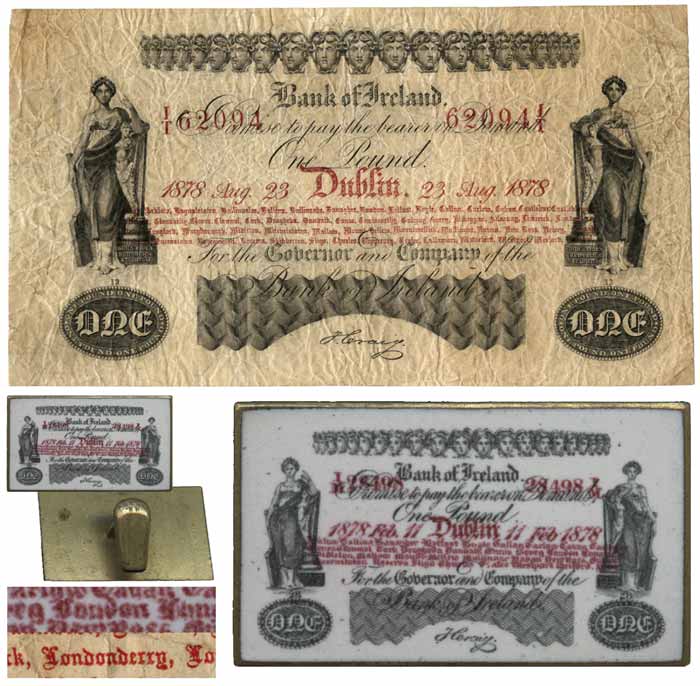
A Brooch of a Bank of Ireland £1 note, 11 Feb 1878 (actual size, and 250% of actual size), and an actual note of the same era. The banknotes are far rarer than the Brooches. Below, the branch name error: below, Londonderry on the banknote is listed as London on the Brooch.
Table 1: Bank branches listed on the Bank of Ireland brooch exactly in the order that they appear on it, including ‘London’, instead of ‘Londonderry’.
Arklow, Banagher, Ballina, Belfast, Boyle, Callan, Carlow, Cavan Castlebar,
Clones, Clonmel, Cork, Drogheda, Dundalk, Ennis, Gorey, London, Longford
Middleton, Mallow, Mount Bellew, Mullingar, Navan, New Ross, Omagh,
Queenstown, Roscrea, Sligo, Thurles, Tralee, Westport, Wexford, Youghal
Several varieties of early brooches
As research progressed, other brooches were quickly discovered of Bank of England notes: £5; and £10, both dated 15 Nov 1876. Other Bank of Ireland brooches had been seen previously, as had brooches of Postage stamps and other similar items of the era. Two more varieties of the Bank of Ireland brooch, were also recorded. The picture began to fill in rapidly. Linking the Bank of England banknote brooches to the Bank of Ireland note brooches became a logical step, especially in view of the error on the Bank of Ireland brooch, indicating its likely unofficial nature. The Bank of England brooches matched the Bank of Ireland brooches in design, in the lack of any maker’s mark, and in the type of fastening pin, type 1, on the reverse. However, one of the Bank of Ireland brooches had a different type of fastener, type 2, designed to fit into a button hole, a fastener also seen on some of the English banknote brooches. Also, there are two versions of the Bank of Ireland brooches, and it appears two versions of the Bank of England brooches, one being of arguably better quality than the other in both cases.
All the evidence was pointing towards the notion that someone was making these brooches for general public use, probably in England, given the subject matter of the brooches, and not in Ireland (hence the understandable error in the name of the Londonderry branch appearing as London on the brooch) in the late 1870s.
A brief note about the Bank of England banknote brooches is on page p191 of the book Jewellery in the Age of Victoria (Gere and Rudoe, 2010). The book illustrates some Victoriana, enamelled jewellery including brooches of a postage stamp and a £10 note dated 10 Nov 1877. It states that ‘The design for the £10 banknote brooch was registered in 1877.’ The book also points out that inexpensive enamelled novelties were quite the rage amongst the educated middle classes of the age. So, mystery solved then—it would seem so.
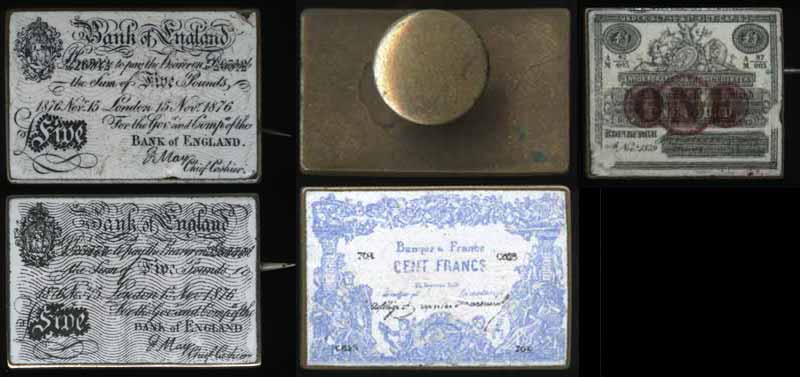
Type 1 Brooches
Other banknote brooches
Collectors are always looking for something new, and to expand their collections and knowledge. I speculated that it was reasonable to assume the existence of a brooch featuring a Bank of Scotland note, given that Scotland was at least as important a part of the United Kingdom as Ireland. After a few months a very nice rendition of a National Bank of Scotland £1, dated 11 Nov 1879 turned up (SCWPM: P232—a rare note). Incidentally, the badge extends the later date bracket listed in the catalogue from 1864 to 1879, assuming the date on the brooch is accurate. The design of the pin on the reverse of the Scottish banknote brooch is similar to the Bank of England and Bank of Ireland Type 1 brooches, indicating similar manufacture characteristics. The dimensions of the brooch itself are different, at approximately 25 x 25 mm, reflecting the square format of the 1879 National Bank of Scotland £1 note.
However, I then discovered two more quite interesting brooches, both Bank of England notes, a £10 dated 11 Apr 1879, and a £20 dated 12 April 1877. These are interesting, as they are smaller sized (22mm x 13mm) than the other Bank of England brooches, have a vertical pin attachment at rear, and unlike the earlier finds, have a stamp on the reverse: ‘DÉPOSÉ’ in uppercase French characters, meaning ‘registered’.
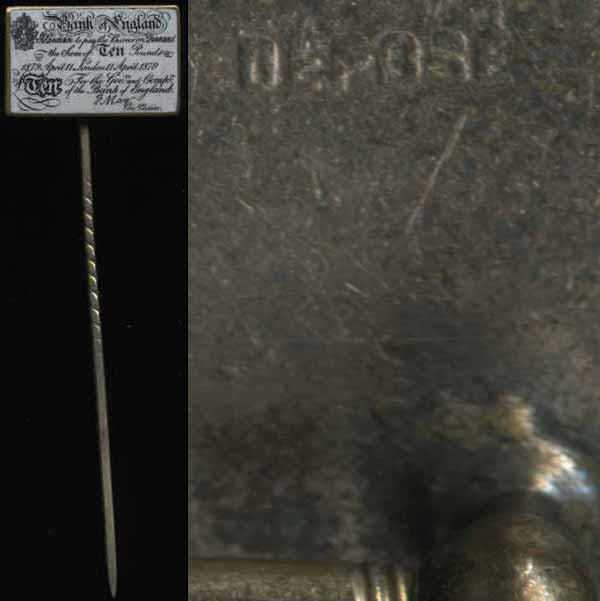
Type 2 Brooch enlarged, with zoom of reverse, showing ‘DÉPOSÉ’ mark.
France, a game changer!
I then came across another, entirely different banknote brooch, that of a French 100 Francs note, dated 15 Jan 1871. This was an unexpected addition to the inventory of brooches. It is exactly the same size as the Type 1 Bank of England brooches, 28 x 20mm, suggesting the same manufacturer as of the brooches depicting the English, Irish and Scottish notes. The fastener on the reverse is similar to the type 2 fastener on the reverse of the Bank of Ireland brooch, for attachment to the wearer’s button hole—perhaps the button hole brooches were for gentlemen to wear and those with pin fasteners were for the ladies. The other noteworthy thing about the French banknote brooch is that the banknote it depicts is dated several years earlier than the brooches depicting banknotes of the British Isles. Would this be evidence of earlier manufacture? The 100 Franc note on the French brooch is of the ‘Blue’ series, in use from 1863 to 1882 (SCWPM: P52b), and there were many dates of issue. The prefix on the note reproduced on the brooch is consistent with the date given in 1871.
The existence of the French banknote brooch points towards a broader story for the brooches in general. Also, similar enamel brooches of postage stamps and other non-British items are extant. The French banknote brooch and the Type 2 brooches with ‘Déposé’ mark on their reverse points towards items of French manufacture. Further research suggested that the brooches were indeed manufactured in France or Bohemia, and that they were part of a wider range of brooches of everyday items such as newspapers and posters. The Harrogate Museum has several of these in its collection. I believe that Type 2 brooches are probably of later manufacture than those of Type 1.
Types and varieties of banknote brooches
Collectors like to classify things into Types and varieties, and I have attempted to do this based on the brooches I have thus far seen. They fall into two general Types: large brooches with various mounting devices; and smaller brooches which are mounted on a long pin. These are set out in Table 2. Were we to consider the other brooches seen, those of publications (‘The Times’, ‘Punch’), they would fit in as Type 1, being of the same dimensions as the Bank of England banknote brooches of Type 1. The Victorian Postage Stamp would also fit into Type 1 because of its fastener.
Table 2: General Types of Banknote brooches seen.
There are two general Types. Type 1, large sized brooches are presumed to be of earlier manufacture. Type 2 brooches are smaller sized and have only been seen mounted on a long pin. There are at least two engravings of the larger type 1 brooches. Engraving A brooches are sharper and better quality impressions than engraving B. There are also other differences between the engravings.
The designs of fasteners on the reverse varies, and they are grouped into general categories. Some fasteners may be later repairs of damaged originals. Serial numbers of banknotes reproduced on brooches are listed in brackets.
General Type 1. Large sized
A. Hinged Stud for buttonhole or similar, with ‘Déposé” mark on reverse.
Bank of Ireland. £1 note 1878 engraving A (I/M 28498)
B. Fixed Stud for buttonhole or similar.
Banque de France. 100 Francs, 1871 (C828)
Bank of England. £5, 15 Nov 1876 engraving A (25777); £5, engraving B (20512)
Bank of England. £10, 15 Nov 1876 engraving A (25777)
C. Hinged pin fastener.
Bank of Ireland. £1, 11 Feb 1878 engraving A; engraving B.
Bank of England. £5, 15 Nov 1876 engraving B (25777), engraving A (26512).
Bank of England. £10, 10 Nov 1877 engraving A (03672); £10, 15 Nov 1876 engraving B (25777)
Bank of England. £20, 12 April 1877 engraving A (14471)
National Bank of Scotland. £1, 11 Nov 1879 (A/M 87/003)
General Type 2. Small sized
A. Mounted on long 70mm pin, with ‘Déposé” mark on reverse
Bank of England. £5, 15 Nov 1876, engraving A (25777);
Bank of England. £10, 11 April 1879, engraving A (14727)
Bank of England. £20, 12 April 1877, engraving A (14471)
On some brooches of Bank of England notes different denominations appear with the same serial numbers.
Some brooches of different denominations bear the same date. Thus, the dates given on the brooches cannot be relied upon as an accurate indication of the actual date on the original banknote, especially in the light of known errors on some brooches.
Brooches depicting other denominations of Bank of England notes have been reported.
Bank of England enameled banknotes have also been reported with a suspension loop on one corner instead of pin attachments rendering them pendants. Miniatures of postage stamps with such attachments are relatively common.
Type 1 brooches, engravings A and B
Engraving A tends to be of better overall quality than engraving B, though this does not necessarily imply that engraving A is the earlier of the two. There are other differences as noted.
The main difference between the two engravings on the Bank of Ireland £1 brooches is the shade of the red branches. On engraving A the branches are a sharp red, on engraving B they are paler, almost orange in appearance. Also, the position of the block of branches is slightly different on the two engravings. Several brooches of each engraving have been seen. The designation of the order of engravings here is arbitrary, as it is not known which of the two came first.
On the brooches of Bank of England banknotes, the main difference is the strength of the wavy lines, representing the watermark, throughout the note. On engraving A, the lines are less pronounced, and on engraving B they are very heavy. Dates on the notes also vary between the two engravings as noted in Table 2. Visually, engraving A brooches are clearer in terms of their design.
Other contemporary brooches
An image of some of these brooches which are part of the Harrogate Museum collection have been uploaded to wikimedia.org on behalf of Harrogate Museum and Arts Service. It displays some brooches of Bank of England notes and other publications of the late 1870s. Richie (2014) states that the brooches of publications were made in England, and that those of banknotes were probably made in France or Bohemia between 1878 and 1887. This possible French connection correlates well with the Type 2 brooches bearing a mark, DÉPOSÉ, also on Type 1A; and the Type 1B brooch of a French banknote, dated 1871 (illustrated). Richie points out an error in the brooch of Punch’s Almanack, as it is dated 1879, but features a cover design used in 1878.
Richie also stated that the Bank of England seized the brooches on import to the UK, regarding them as a threat to British currency under the Forgeries Act, though it is not specified in the book when exactly this occurred. Yet Rudoe and Gere (2010) state that the design of the £10 banknote brooch was registered in 1877, from the context presumably in the UK. Possibly then, after some initial issues around the notion of forgery, the French-manufactured brooches were allowed to be imported to the UK by 1877. Could later versions have then been made locally? Note that the dates on the brooches featuring Irish and Scottish banknotes are 1878 and 1879 respectively, suggesting that they were produced after the registration of the design of the Bank of England £10 note brooch.
Some of the Postage Stamp brooches are obviously contemporaneous with the banknote brooches. The penny red brooch illustrated has a fastener which is very similar to that on the Type 1A Bank of Ireland £1 note brooch. Other penny red brooches have been seen with Type 1C pin fasteners. The brooch of the Russian postage stamp depicts a 7 Kopec stamp from the 1880s, it has quite an elaborate attachment pin not seen on any of the banknote brooches. Pendants of this stamp have also been seen. The German 20 Pfennig postage stamp pendant depicts a stamp from the series starting in 1902. The postage stamp brooches and pendants are all of similar size, at approximately 20mm x 16mm. All of these point towards a widespread availability of these brooches and pendants in many countries, commencing around 1870. The French banknote remains the earliest object depicted on any of the brooches.
A trend in the quality of the objects is apparent. Earlier versions are better representations of the original subject, and are made of better materials with more elaborate fasteners. Later on, the trend seems to have been to create pendants rather than brooches. Possibly brooches fell out of favour with buyers towards the end of the Victorian Age.
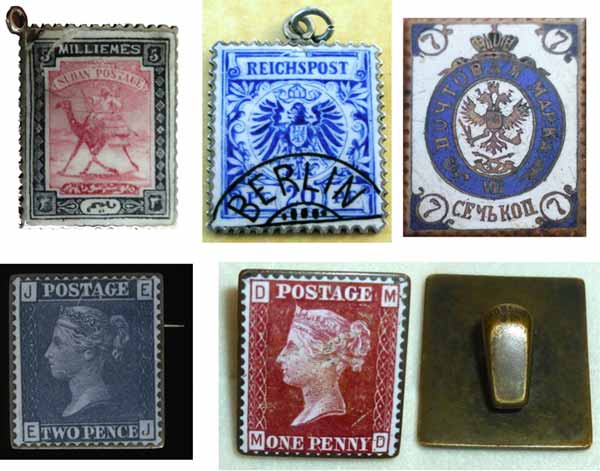
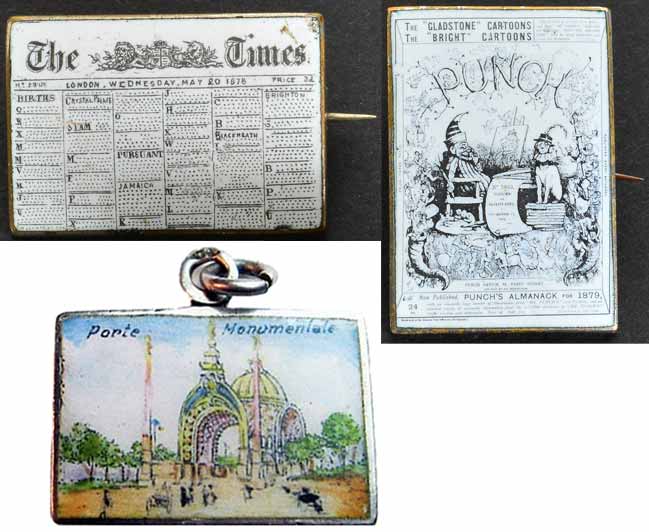
Enamel brooches and pendants of other items from the same era. (Not to Scale).
Times and Punch are from the Harrogate Museum, and are the same size as the Type 1 Bank of England banknote brooches.
Further research
The story of these brooches is far from complete, and a lot of research remains to be done. There are likely other brooches, featuring different denominations of Bank of England banknotes, waiting to be catalogued, as well as brooches featuring other notes. Hopefully this article will serve as an inspiration for those with new information on the brooches, and for anyone in possession of brooches not mentioned here to send a picture of any new discoveries to the author via this forum, where updates and information on the banknote brooches are posted.
References
Ritchie, H., (2014) A Passionate Collector: Mrs Hull Grundy and Jewellery from the Harrogate Collection., p85. The Mercer Art Gallery, Harrogate.
Rudoe J., Gere, C. (2010). Jewellery in the age of Victoria: A Mirror to the World., p161. British Museum Press.
Standard Catalog of World Paper Money: General Issues to 1960. (2014). 15th Ed. F+W Media Inc.
Times and Punch brooches are from Harrogate Museums and Arts: https ://commons. wikimedia.org/wiki/File:19th_Century_Novelty_jewellery_in_the_form_of_real_documents_and_publications.JPG posted by Jonathan Fenny of Harrogate Museums and Arts service (Last accessed: Feb 18, 2016).

